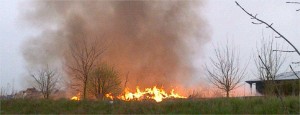An employee discovered a small fire upon arriving at around 6:45 a.m. at the waste collection and sorting facility where he worked. The flames spread from a 40 m³ pile to a 150 m³ outdoor storage area containing recyclable industrial waste (containerboard, paper, plastic, wood). The fire sent up plumes of smoke that moved eastward. Using means available on the site (digging of a trench to break the fire’s path, movement of nearby stockpiles, etc.), the fire-fighters were able to extinguish the flames using a fire hydrant located near the entrance. The extinguishing water was contained in the rainwater network and was subsequently pumped out and disposed of by a specialist firm (four 59 m³ tanks). The fire-fighters left at about 10:00 p.m. The gendarmes, the mayor and the inspection authorities for classified facilities arrived at the scene. The fire, which smouldered at first, may have been caused by what is referred to as ‘the burning-glass effect’ (the room used for storing waste awaiting sorting has glazed doors and the sunlight was strong the day before the blaze) or by an improperly extinguished cigarette butt (although the break room is non-smoking, it is located near the pile and hidden from view).
The inspection authorities found that the fire-water pond was not used to extinguish the flames although it is located near the seat of the fire. It also discovered that the strainers located at the bottom of the two suction tubes were clogged with residue and therefore impeded suction.
The operator checked to see if the fire had damaged the bituminised platform (integrity test) and concrete partition walls. It cleaned all its networks and had the suction tubes cleaned and the fire-water pond desludged. It also reminded its employees that smoking is prohibited except in the designated area and moved the break room away from the work areas. From now on, only small amounts of NHIW are placed outside pending sorting, and sorting is performed indoors.




